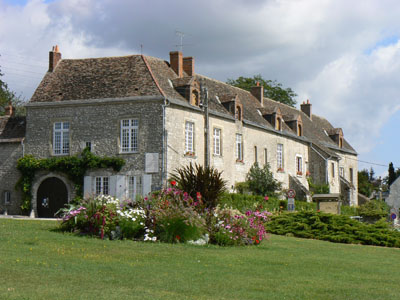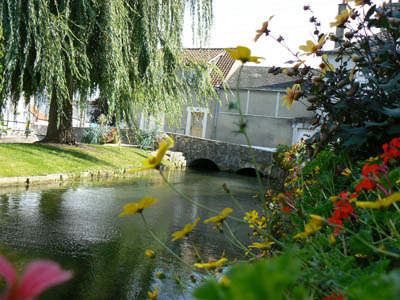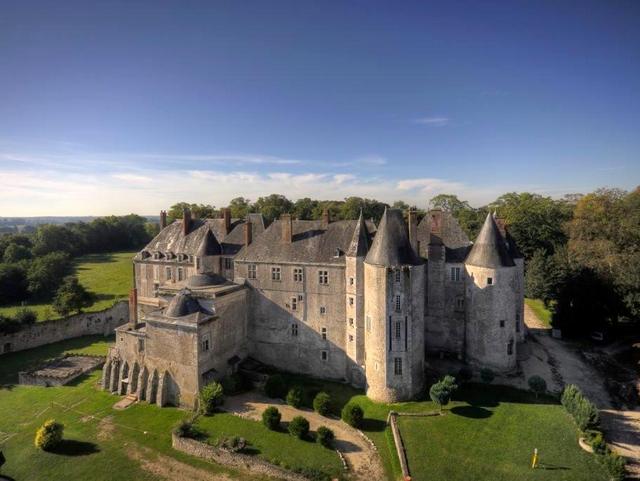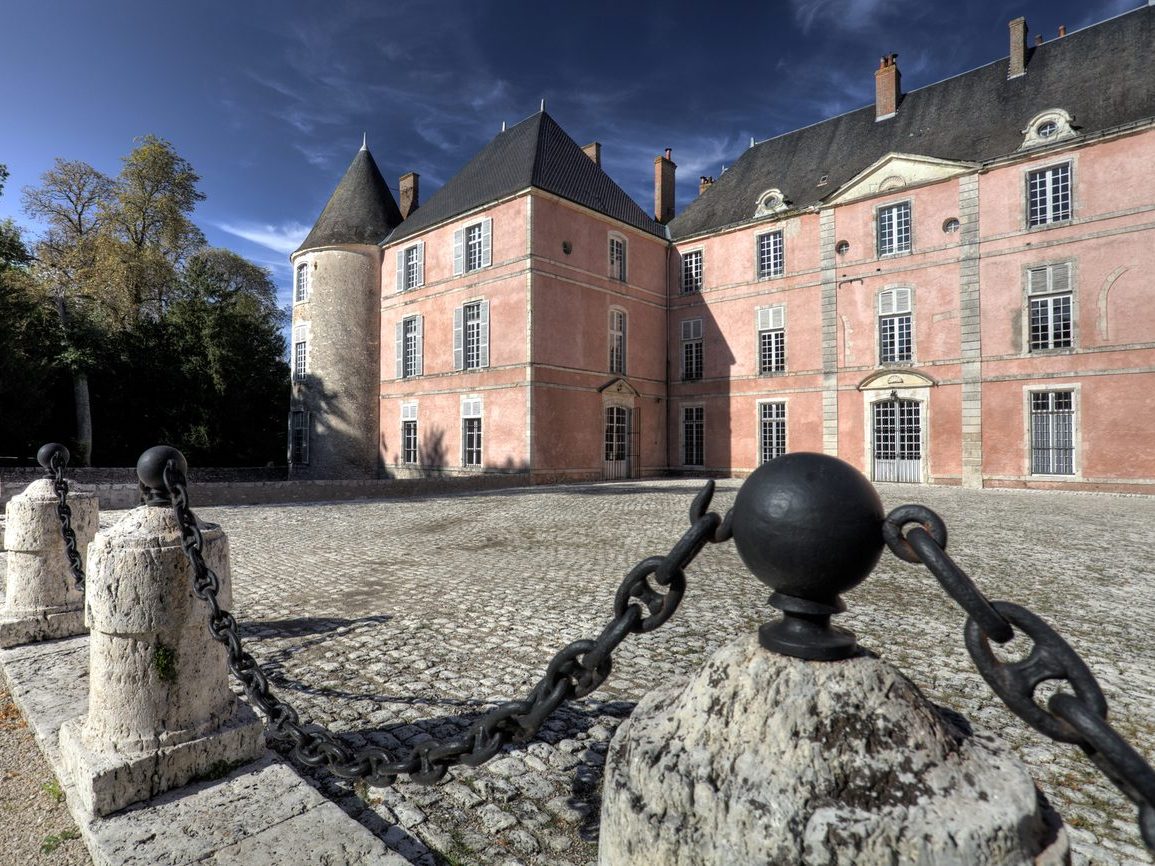With a population of a little over 6,000 inhabitants, the town of Meung-sur-Loire is located 17 km from Orléans on the banks of River Loire between the Beauce and the Sologne. The town’s name derives from “Magdunense”, meaning a market (magos) protected by a fortress (dunum).
The old town of Meung-sur-Loire

The old town of Meung is worth a visit with its maze of intriguing yet peaceful narrow streets.
While strolling in the old part of town, the visitor will discover old half-timbered and stone houses with mullioned windows, the wooded market hall, flowered gardens and statues, and intimate little squares with lime-trees.
To add to the charm of Meung, little streams locally known as “les Mauves” cross the town where the water-wheels of the mill houses were once active.
The castle of Meung

The castle of Meung-sur-Loire was originally the country residence of the Bishops of Orléans. This castle, listed as an historic residence by the French State, was successively built between the 12th and the 18th centuries. As one of the Loire’s oldest fortresses, Meung Castle has welcomed illustrious characters from French history across the centuries: Charles the Bald, Francis I, Charles VII, Louis XI, François Villon and Joan of Arc.
The park encircling the castle extends over 7 hectares. Featuring green lawns and woods, they provide a peaceful stroll in the shade of centuries-old lime trees.
Find out more about the Castle of Meung-sur-Loire.
St. Liphard Church
![Meung-sur-Loire Saint-Liphard © Croquant - licence [CC BY-SA 3.0] from Wikimedia Commons](https://frenchmoments.eu/wp-content/uploads/2013/10/Meung-sur-Loire-Saint-Liphard-©-Croquant-licence-CC-BY-SA-3.0-from-Wikimedia-Commons.jpg)
The Saint Liphard Collegiate is a local jewel of religious architecture built nearly 1,000 years ago. The lower part of the bell tower was built in the 11th century whilst its bell room and stone steeple date back to the 13th century.
It features a semi-circular chevet and an original transept whose rounded extremities form a clover.
A fortified building (the Tour Manassès de Garlande) flanking the nave and the bell tower was added by Manassès de Garlande, Bishop of Orléans in the 12th century.
Amont Gate

The fortified gate of Porte d’Amont is the only remnant of the wall that used to encircle the town.
The ramparts around Meung were built in the mid-11th century and were opened by four gates of which only the Porte d’Amont remains. From the gate, the gatekeepers used to sound the alarm in the event of danger. Once the harrows lowered down and the drawbridge pulled up, the gatekeepers and the rest of the population took their positions to defend their town. The present-day gate was built in 1629 on the site of the former medieval one and was again restored in 1870.
This gate played an honorific role by being the meeting site of the municipal council.
The bell located in the bell-turret was made by Parisian bell caster Crouze-Hildebrandt and plays A flat. Interestingly, the clock dial on the city side shows 61 minutes!
The gate has been listed as a “Monument Historique” by the French State since 1925.
The watermills

The first watermill houses in Meung were built in the 12th century. Essentially dedicated to the production of flour, it was only from the 15th century that tanning, flour and paper mills appeared. They were set on the “Mauves”, little streams that cross the old town.
Between the 14th and the 19th centuries, 29 mill houses were active in the town of Meung, either belonging to the local lords or religious congregations.
The last watermill closed in 2010 but many of the mill houses are still standing today. A permanent exhibition about the mills of Meung is on display at Meung’s Tourist Office.
The Grand Stables

The Grande Escurie, built on the banks on the Loire, used to house a royal stud farm. It was founded in 1338 and is one of the oldest in France. It was the private property of the king who would pass by Meung on his way to Chambord or Blois.
The king needed to resupply, change horses and spend a night at the relay. The stud farm was closed in 1604 and today houses a high ranking hotel-restaurant.
Gardens near Meung-sur-Loire

There are many exceptional gardens to visit around Meung-sur-Loire:
The Roquelin Gardens extend over 1 hectare and feature pergolas covered with old rose species, a kitchen garden, a water plant basin and an English garden. They have recently been listed as “Jardin Remarquable” by the French Ministry of Culture. Visit the website.
The Arboretum of Prés de Culands is a private domain of 2 hectares developed on marshlands. The park contains more than 400 different species of holly trees (ilex) over a landscaped garden featuring islets connected with wooden bridges. Visit the website.
The park is open between April and September. Listed as “Jardin Remarquable” by the French Ministry of Culture, it has also been recognised as an “Official Holly Arboretum” by the Holly Society of America since 1999.
The Mauves

The little rivers that cross the town of Meung are called “Mauves” and were man-made. The source of the water is the Beauce water tables which flowed into marshlands. In the Middle-Ages, a monk named St. Liphard ripped out the swamps and channelled the water into three streams known as “la Grande Mauve” (21 km), “la Mauve du Ponceau” (7 km) and “la Mauve de la Fontaine” (6.6 km) the moving waters of which were used to run watermills. Alongside, several arms called “divises” complete the water network measuring 42 km. The “mauves” and “divises” eventually converge into one large “Mauve” that empties into the Loire River, south of the old town of Meung. There are 4 walking itineraries along the “Mauves” and their old watermills which provide peaceful and picturesque strolls.
How to get to Meung-sur-Loire

By air
Paris’ airports Charles-de-Gaulle and Orly are about 150 km away from Meung. It is possible to rent a car from there and drive to Meung via the A10 motorway.
By road
Meung-sur-Loire is easily accessible from Paris (145 km) via Autoroute A10 (French for motorway).
The town is located 17 km from Orléans and 35 km from Blois.
By train
A railway station located near the historic centre of Meung provides several daily services to Blois, Tours and Orléans. Change at Orléans for connecting trains to Paris-Gare d’Austerlitz.
English-French Vocabulary

(f) for féminin, (m) for masculin, (adj) for adjective and (v) for verbs
- bank = rive (f)
- bell = cloche (f)
- bell tower = clocher (m)
- bishop = évêque (m)
- castle = château (m)
- chapel = chapelle (f)
- chevet = chevet (m)
- collegiate = collégiale (f)
- drawbridge = pont levis (m)
- façade = façade (f)
- fortress = forteresse (f)
- French Revolution = Révolution Française (f)
- garden = jardin (m)
- gate = porte (f)
- holly = houx (m)
- Hundred Years War = Guerre de Cent Ans (f)
- Joan of Arc = Jeanne d’Arc
- lawn = pelouse (f)
- lime tree = tilleuil (m)
- Loire Valley = Vallée de la Loire (f)
- Middle-Ages = Moyen Âge (m)
- mill house = moulin (m)
- mullioned window = fenêtre à meneaux (f)
- municipal council = conseil municipal (m)
- park = parc (m)
- relay = relais (m)
- stream = ruisseau (m)
- stud farm = haras (m)
- swamp = marécage (m)
- town = ville (f)
- transept = transept (m)
- Wars of Religion = Guerres de Religion (f,p)
- watermill = moulin à eau (m)
- wood = bois (m)
- World Heritage Site of Unesco = Site du Patrimoine Mondial de l’Unesco (m)
We would like to thank the Tourist Office of Terres du Val de Loire in Meung-sur-Loire for providing photos.
Featured image: Meung-sur-Loire © P.Hirsch




